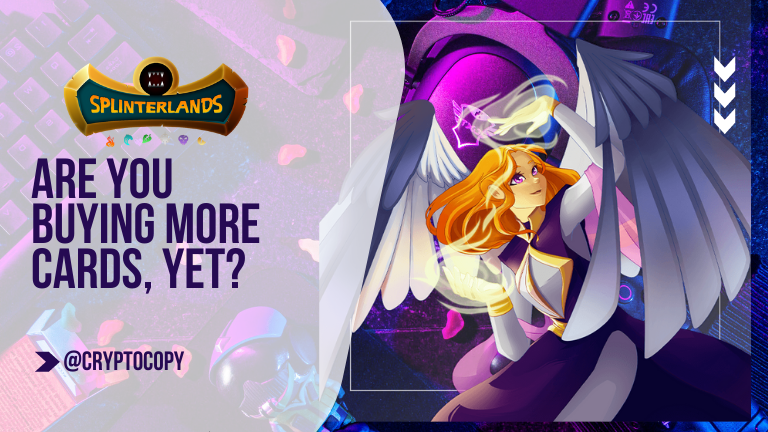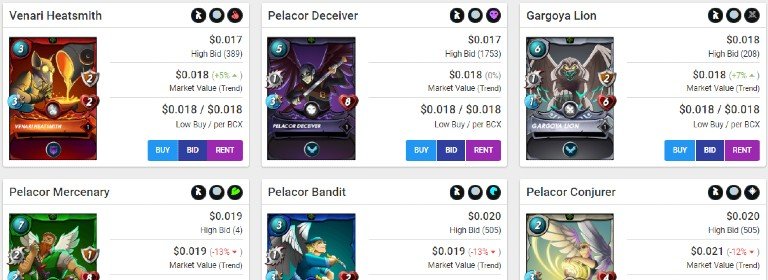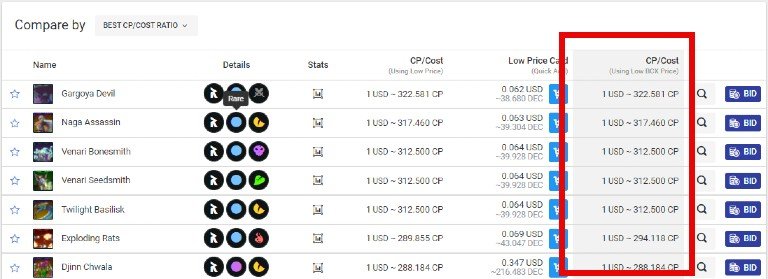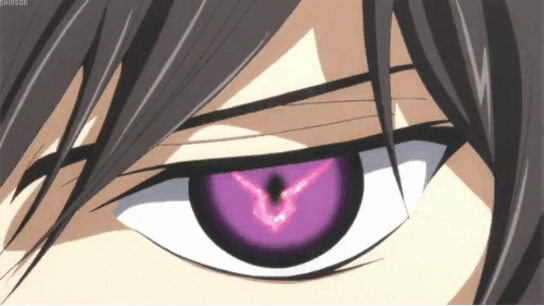
Is now a good time to buy Splinterlands cards?
It is for me.
Over the past few weeks, I have been doing my best to grow my Splinterlands play2earn card collection so I can transition from renting 90% of the cards I play with to, hopefully, owning 90% of them. Why do I think now is a good time to buy?
Here are my 5 reasons for buying Splinterlands cards today.
1. To take advantage of the decreasing price of cards
Card prices, in general, are down. However, this doesn’t mean it will remain the case for long. Thus, it’s a good idea to take advantage of today’s inexpensive prices, before they pick up again.
Look at the trend on Beta cards, for example. Intrigued by @tanzil2024’s recent post on the prices of non-Chaos Legion cards, I did some sleuthing using the historical charts from Splintercards.com’s List Price Analysis Tool. Here is what I found regarding the price of Beta Cards. (Note that these charts were generated on 22 April 2022.)
First, the price of almost all Beta Cards has decreased significantly over the last three months. The biggest decrease, for example, affected the Beta Selenia Sky. A very useful Dragon Summoner with a +1 Range attack and only 3 mana costs, the Beta Selenia Sky is 70% cheaper today with single cards selling for only $91.99—down from its three-month average of $275.92, and its price from three months ago of $324.99.

So, does this mean Beta Cards are a bad investment for non-players? Are these cards not retaining their value?
That’s not the case at all. In fact, if you look at the prices of all Beta cards from 390 days ago, almost all of them have at least doubled in price, with more than half higher by at least 500%.
Even the card with the lowest 390-day increase, the Magi Sphinx, is still 96.2% higher going from $9.65 to $19.94. And the Beta Selenia Sky, despite the large drop in price in the last 3 months is still 152% more expensive today compared to 390 days ago when it was selling for only $36.50.


What could these price movements mean? That Splinterlands card prices are experiencing a dip and that they are likely to rebound, if not at least maintain their current price. Thus, buying today gives players and investors an opportunity to build their playing decks and card portfolios at lower prices.
2. To avoid the starter card penalty
In last month’s Town Hall Splinterlands announced that the more Starter cards you use in ranked battles, the less DEC you will earn from ranked rewards. Thus, it’s a good idea to replace Starter cards with those that you own to avoid this “penalty”. And given the lower price of cards, now is a good time to do this.
3. To increase SPS airdrops
Aside from their usefulness to players, owning cards can help increase Collection Power (CP) and, as a consequence, Splintershards (SPS) Airdrops. With every CP point equivalent to 1 airdrop point, accumulating about 13,535 CP as of 26 April 2022 will give you approximately 1 SPS every day for the airdrop’s remaining three months.
And because the amount of CP required to receive 1 SPS airdrop per day increases every day, it is a good idea to keep increasing your CP, too, if you want to maintain your current airdrop rate.
Just keep in mind that this might not be the most efficient way to increase SPS airdrops. But it is still a good bonus for building your deck.
4. To receive extra benefits from third-party marketplaces
One of the best things about Splinterlands (and Hive, in general) is that decentralization has given players a variety of choices on where to buy their cards. And with the competition among third-party marketplaces gearing up, Splinterlands card buyers are offered different benefits to help them choose one over the other.
These benefits include cash backs in the form of DEC for purchases when you buy from either MonsterMarket.io where they give you a 60% DEC cashback on their fees (so, approximately 3% of the card price), or from Cardauctionz.com which gives a 3.25% DEC cashback on the purchase price.
And then there is Peakmonsters.com which airdrops its own PKM token to users. Peakmonsters users users can use these tokens to join exclusive tournaments, to exchange for other tokens in the market, or to hodl in their accounts.
More than offering perks to card buyers, however, these bonuses are prime examples of the compounding power of Hive and Splinterlands. For example, the DEC bonuses you receive from buying at MonsterMarket or CardAuctionz can add to your account’s Collection Power (CP), thereby adding to your SPS airdrop points. On the other hand, the PKM tokens from PeakMonsters can be traded for HIVE, thereby presenting opportunities to earn and profit.
In all instances, regardless of which third-party market you purchase the Splinterlands cards, buying them generates more value than just the card, itself.
5. To transition to a long-term play2earn strategy
Finally, if you plan to get involved in Splinterlands for the long run and want to get the most out of its play2earn gaming model, card ownership is a better long-term strategy than renting.
First, card owners are not beholden to the rental market. At the moment, if we look at a Splinterlands Season, the End of the Season (EOS) usually means higher rental increases, especially toward the last two days. The result is some form of unofficial EOS tax that renters pay every two weeks.
Second, apart from the increase in prices, the EOS usually brings about a decrease in DEC rewards from ranked battles. It’s important to understand that the total number of players battling is one of the variables that determine the amount of DEC that can be earned for every ranked battle win. This means that with more players battling as the season progresses, DEC rewards also decrease as the season ends.
Thus, if you combine the increased rental prices with the usual decrease in DEC rewards as we approach the EOS, most renters encounter a double whammy of high costs plus low rewards for their rentals. Although these could be acceptable in the short term, they could translate to quite the expense in the long run, especially if you rent 90% of your playing cards, like me.
Thus, it is in the best interest of players to avoid or diminish this, as soon as possible, by owning their playing deck.
And third, if we look at the last boom cycle when all Splinterlands assets went up in price, it was those who owned their assets, particularly the card owners, who benefitted the most. Whether that’s from profits in more expensive card sales, higher SPS airdrops, or the increase in rental fees paid to them, much of the economic benefits went to card owners.
Thus, for those who want to prepare for the next boom cycle, now is a good time to start accumulating assets by buying Splinterlands cards.
But buying cards doesn’t mean stopping renting them
Does that mean we should stop rentals altogether? Of course, not. I am still a big fan of rentals and there are many situations where players could benefit from renting.
Here are a few of them:
To bolster a player’s deck strength during special events like brawls and tournaments. It takes time to build a powerful deck, thus before you get there, renting is a great way to access powerful cards for important battles like brawls and tournaments.
To try out certain cards before committing to buy them. Unless you have an unlimited budget, it’s a good idea to rent so you can test a card in battle before you buy. Maybe the card isn’t as powerful as you thought it could be in action? Or maybe the card’s usability is not as high as you expected?
To boost deck power to meet league requirements. Do you want to play above your deck level for a season? Maybe you’ve practiced enough in the Silver League and want to see how well you perform if you advance to the Gold League. Renting lets you test your skill without having to upgrade all your cards.
The point is, there’s nothing wrong with renting. As long as you’re renting for the right reasons. And as long as you don’t get too comfortable with it.
Getting out of the card rental trap
As I mentioned in the previous section, there’s nothing wrong with renting cards. In fact, I’m still renting a lot of cards to play the game. However, what I’ve come to realize is that the best long-term strategy is always going to be card ownership.
So, the goal is to take advantage of the dip in card prices by slowly building my deck so I can play in the Gold Leagues with fewer rentals.
But, since I’m a player on a budget, I will have to do so gradually. And the best way to do this is by dollar-cost-averaging my way into a better Splinterlands card collection.
Over the past few days, I have begun to buy cards in the market at semi-regular intervals—about twice a week, spending $10 to $20 every time. It’s not a lot, as I said, I’m a player on a budget. But, in the two weeks that I have been doing this, I managed to get the biggest increase in my Collection Power (about 15,000 more) since I started playing again last year.
Considering that I spend more on rentals every season, this seems to be a better way to spend my Splinterlands resources.
What cards am I buying right now? And how am I finding good deals on cards?
How to find good card deals: Best CP/Cost Ratio
At the moment, I have only started to really build a collection. Granted, I have had a decent set cards from the pre-Untamed era. But except for a few cards, most of them are not battle-ready. So, I’m buying cards as if I am just starting a collection.
Thus, the goal is simple—get the best bang for my buck. It doesn’t matter what the card is, as long as it is a good deal and I can use it while playing. For this, one tool that I find really useful is Peakmonsters’ Best CP/Cost Ratio filter.
The Best CP/Cost Ratio filter lists all the cards based on how much Collection Power (CP) each card gives, for every dollar spent. It’s a pretty useful tool if you’re on a budget and want to get the best bang for your buck.
How does it differ from the default market view? Unlike the normal market view where you are shown either the cheapest card per BCX or the cheapest card based on price, this view takes into consideration Collection Power in determining what is cheapest.
For example, the normal view will show the Venari Heatsmith as the cheapest card in the market selling at $0.018 per BCX. However, the Best CP/Cost Ratio view will display the Gargoya Devil selling at $0.062 per BCX as the “best” buy card, instead.


That’s because 1 BCX of the Venari Heatsmith only has 5 CP, compared to the 20 CP you get from 1 BCX of the Gargoya Devil. Using this filter, the Heatsmith is therefore “more expensive” since you are only getting 285.714 CP per dollar from it, compared to the Devil, which gets you 322.581 CP per dollar.
If you’re after increasing your CP, this could be a pretty useful tool to consider.
To use the Best CP/Cost Ratio filter, you simply have to:
Go to the Peakmonsters Market.
Click on the Compare button on the top-right-hand side.

Then, choose the Best CP/Cost Ratio option under the Compare By dropdown menu.

From here, you can find the cheapest 1 BCX card per Collection Power in the market. And like the rest of Peakmonsters views, you can further refine your search to limit just cards to a specific Splinter, rarity, or card edition, depending on what you need.
This way, you're not just finding the cheapest cards in the market, but also the cheapest cards that could have a bigger impact on your collection power.
Final Thoughts
It’s a good time to start buying cards to build your deck, especially if you plan to play long-term. The price of cards has gone down, so why not take advantage of the dip? This way you won’t be at the mercy of the rental market, not to mention the upsides to owning cards—SPS airdrop points and higher rewards compared to using starter cards.
It doesn’t mean you should stop renting, though. Renting will always have a place in the game, it’s just a matter of figuring out how to use rentals to your advantage.
In my case, since I want to keep playing while building my deck, I will keep renting, while slowly adding to my collection using a dollar-cost-averaging strategy. This way, I'm not spending too much at once.
Hopefully, I will have dollar-cost-averaged my way to a more profitable deck when the next Splinterlands boom cycle comes around.
After all, it's about time I get out of the rent race and grow my own card collection.
Tools and websites mentioned:
- Splintercards.com - a compendium for Splinterlands players with tools and statistics for both new and expert players.
- MonsterMarket.io - an external card market for Splinterlands with DEC cashback for card purchases.
- CardAuctionz.com - an external card market for Splinterlands with DEC cashback for card purchases.
- Peakmonsters.com - an external market for buying and renting cards for Splinterlands with PKM airdrops for card purchases.

What is Splinterlands?
Splinterlands is the next generation of collectible card games that allows players to collect, trade, and battle with provably scarce digital collectibles with real-world value.
Interested? Join Us.
Notes and Disclaimer: The cover art was created using images from Splinterlands and Canva Pro. The use of screen captures in this post is meant to educate and comment on the topic and is deemed fair use. The content in this post is for informational purposes only, you should not construe the content in this blog as legal, tax, investment, financial, or other advice.





